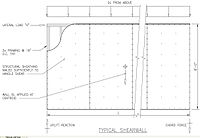
Photo from wikipedia
Lateritic clay is well recognized to contain significant amount of iron and aluminium oxides (sesquioxide). These oxides enhance the formation of soil aggregates which would greatly affect soil structure. So… Click to show full abstract
Lateritic clay is well recognized to contain significant amount of iron and aluminium oxides (sesquioxide). These oxides enhance the formation of soil aggregates which would greatly affect soil structure. So far, no study has been carried out purposely to investigate the influence of aggregate-dependent structure on the mechanical behaviour of the lateritic clay. In this study, structure effects on the compression and shear behaviour of a saturated lateritic clay were studied. Intact, recompacted and reconstituted specimens were studied through oedometer, isotropic compression and consolidated undrained shear tests. Microstructure of these specimens was determined using the mercury intrusion porosimetry and scanning electron microscopy (SEM) techniques and then used to explain the observed behaviour. It was found that the compressibility of recompacted/reconstituted specimens was about 90% larger than intact specimen. Different from soft clay, the influence of microstructure does not show an obvious reduction in compressibility after yielding. The peak shear strength of intact specimen was about 100% higher than those of reconstituted/recompacted specimens. The significant difference in compression and shear behaviour is mainly because the aggregates of intact specimen were about 90% larger than those of reconstituted/recompacted specimens, as revealed by the SEM results. As a result, particle contacts forming the force chain were therefore larger in the intact specimen. The intact specimen therefore became less compressible and more dilative.
Journal Title: Acta Geotechnica
Year Published: 2020
Link to full text (if available)
Share on Social Media: Sign Up to like & get
recommendations!